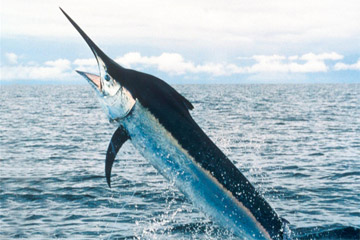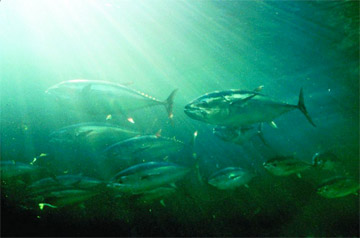Sleek, powerful tunas and billfishes that ply the open ocean garner some of the highest prices of any fish. In January, a single bluefin tuna fetched a record $396,000 at a Tokyo auction. Yet wild fish populations pay a still higher price for such exorbitant demand: the threat of extinction.
The first assessment of an entire group of commercially valuable marine species found that the most threatened fish are generally the ones reeling in the most money, including bluefin tuna and bigeye tuna. The authors applied the criteria of the International Union for the Conservation of Nature (IUCN) Red List, a framework used to assign a conservation status to plants and animals around the world. The study appeared in the July 15 issue of Science.
“This use of a widely used standard for commercial fishes, this is a first,” said lead author Bruce Collette of the National Marine Fisheries Service in an interview with mongabay.com. While regional fisheries managers typically only look at a portion of a fish’s distribution, Collette says, “We looked at the species on a worldwide basis.”
 Blue marlin are one of two billfishes classified as “vulnerable” to extinction on the International Union for Conservation of Nature Red List. Photo: National Marine Fisheries Service |
Collette coordinated an international team that analyzed all 61 species of scombrids (a group including tunas, bonitos and mackerels) and billfishes (which include swordfish, sailfish and marlins). They listed each species in one of six IUCN categories. Nearly two-thirds of the species in this diverse group were classified as species of “least concern,” the mark of healthy populations.
However, the consortium of 33 authors listed seven species as “vulnerable,” “endangered,” or “critically endangered,” the three labels that raise a conservation red flag. The authors noted that five of these species are tunas and billfishes that can take a long time to reproduce, and have high economic value: southern bluefin tuna, Atlantic bluefin tuna, bigeye tuna, blue marlin and white marlin.
Regional fisheries managers set quotas for these ocean-crossing species, which all countries in each region must agree to enforce. However, the lucrative lure of supply and demand often outweighs playing by the rules. As fish populations decline, rarity adds to their price, which spurs increased—and sometimes illegal—fishing. “This means the last bluefin is worth more than the boat that’s caught it,” Collette says.
 Atlantic bluefin tuna cross through the Stellwagen Bank National Marine Sanctuary in Massachusetts during their annual migrations. These fish are classified as “endangered” on the International Union for Conservation of Nature Red List. Photo: NOAA National Marine sanctuaries |
Jennifer Jacquet, a post-doc at the University of British Columbia who researches cooperation and the tragedy of the commons in fisheries, said the extent of illegal fishing suggests the true status of these fish is probably more dire than the authors’ classifications, which drew from official catch data.
Jacquet, who was not involved in the study, says its findings—while not surprising—represent a call to arms by gathering the consensus of so many authors. “The battle really now is in the hands of policymakers,” she said in an interview with mongabay.com.
Both Collette and Jacquet say a key step for fish conservation is a listing under the Convention on International Trade in Endangered Species of Wild Fauna and Flora (CITES), which would regulate their trade. However, such a proposal to list the Atlantic bluefin failed to pass in March 2010, casting doubt on the political will to proceed. The new paper, Collette hopes, may sway some views.
“It’s an interlocking, interconnected, international affair,” Collette says. “There are no simple solutions.”
CITATION: B. B. Collette et al. High Value and Long Life—Double Jeopardy for Tunas and Billfishes. Science 7 July 2011. DOI: 10.1126/science.1208730
Erin Loury is a graduate student in the Science Communication Program at the University of California, Santa Cruz